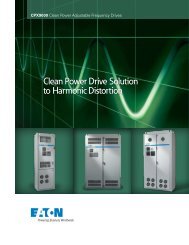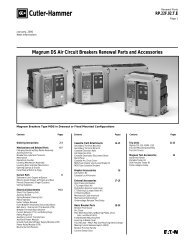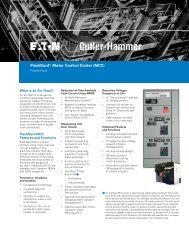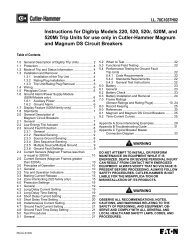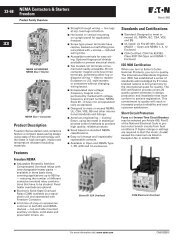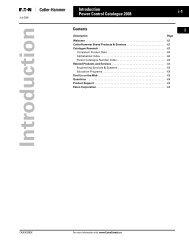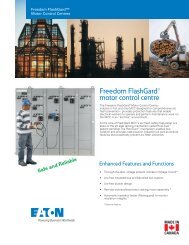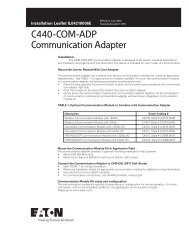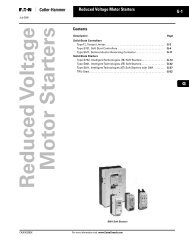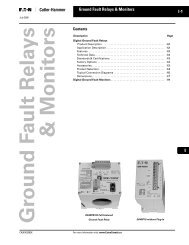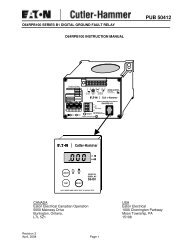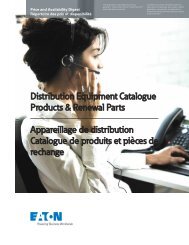molded case circuit breakers - Eaton Canada
molded case circuit breakers - Eaton Canada
molded case circuit breakers - Eaton Canada
Create successful ePaper yourself
Turn your PDF publications into a flip-book with our unique Google optimized e-Paper software.
96<br />
PANELBOARDS<br />
PRODUCT DESCRIPTION<br />
Panelboards and switchboards are enclosed assemblies for lighting and distribution that accept incoming power and consist of a series<br />
of <strong>circuit</strong> <strong>breakers</strong> and/or fusible switches. These devices protect each <strong>circuit</strong> by providing overcurrent and short <strong>circuit</strong> protection.<br />
Cutler-Hammer NFB Cutler-Hammer MP40 Cutler-Hammer CHB Cutler-Hammer EE<br />
Westinghouse FDP Westinghouse<br />
Pow-R-Line 3<br />
PRODUCT HISTORY<br />
In 1994, Cutler-Hammer acquired the<br />
Distribution and Control Business Unit<br />
(DCBU) of Westinghouse. This product<br />
history tracks the evolution of panelboard<br />
and switchboard products for both<br />
manufacturers.<br />
In the 1920s, prior to the development of<br />
<strong>circuit</strong> <strong>breakers</strong>, Westinghouse sold panelboards<br />
designed for main and branch<br />
<strong>circuit</strong> fuses. Circuit <strong>breakers</strong> were first<br />
introduced in 1927 and put Westinghouse<br />
in the forefront of <strong>circuit</strong> breaker technology.<br />
A few years later the first Westinghouse<br />
“NOFUSE” <strong>circuit</strong> <strong>breakers</strong> were<br />
introduced. “NOFUSE” panelboards were<br />
initially available in ratings up to 225<br />
amperes at 250 volts. Panelboards were<br />
designed at higher ratings as <strong>circuit</strong><br />
<strong>breakers</strong> ratings became available. By<br />
1958, panelboards were available at ratings<br />
up to 800 amperes and 600 volts.<br />
The most significant panelboard types<br />
were the CDP and FDP panels. For more<br />
than 34 years, these two types encompassed<br />
most Westinghouse <strong>molded</strong> <strong>case</strong><br />
<strong>breakers</strong> and fusible switches.<br />
In 1962, Cutler-Hammer entered the panelboard<br />
and switchboard market with the<br />
purchase of Mullenbach. Soon after the<br />
Mullenbach acquisition, Cutler-Hammer<br />
entered into an agreement with Westinghouse<br />
to supply <strong>breakers</strong> and fusible<br />
devices for panelboards and switchboards<br />
and Cutler-Hammer also began manufacturing<br />
Westinghouse type panelboards<br />
under the agreement. This relationship<br />
made in the early 1960s provided users of<br />
both trade name products access to aftermarket<br />
service for add-on branch devices<br />
and hardware. Classic Cutler-Hammer<br />
panelboards and switchboards were<br />
designed and listed for use with Westinghouse<br />
<strong>breakers</strong>.<br />
NOTE: Switchboards manufactured by Cutler-Hammer and Westinghouse.<br />
Westinghouse WEB Westinghouse CDP<br />
In 1988, Westinghouse redesigned the<br />
panelboard and switchboard line to incorporate<br />
the new Series C design <strong>breakers</strong>.<br />
This new design became a true family of<br />
products. These new panelboards and<br />
switchboards became today’s Pow-R-Line<br />
Family which are manufactured in stateof-the-art<br />
facilities strategically located<br />
throughout the United States.<br />
Cutler-Hammer’s unique Satellite plants<br />
support aftermarket services for all current<br />
Pow-R-Line panelboard and switchboard<br />
products. Aftermarket service for out-ofproduction<br />
panelboards and switchboards<br />
for both the classic Westinghouse and<br />
Cutler-Hammer designs is supported by<br />
the Aftermarket Center in Sumter, SC and<br />
is staffed with experienced and knowledgeable<br />
representatives.<br />
March 2001



